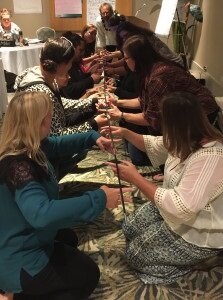Learning cultural humility in Hawaii
Posted by Cindy Carraway-Wilson on Sept. 16, 2016
An exercise at the Youth Thrive training, 2015.
In July, I went to Honolulu to lead a Youth Thrive training for 14 youth-service providers under the auspices of the Hawaii Youth Services Network. The providers were an amazingly diverse group. They worked with young people between the ages of 7 and 24 in middle and high schools; in reproductive health programs; and in programs for runaway and homeless youth. Among the group was someone from every Hawaiian island and three from Saipan, the largest island of the Northern Marianas.
If you’ve ever brushed up against the US Census, you know that these folks are collectively known as “Pacific Islanders.” So they’re one race, ethnicity, and culture, right? Wrong. Well, they’re essentially the same, right? Wrong.
What this training really drove home for me was how many subcultures exist within our large demographic constructs. And that’s just what demographic umbrellas are: a construct, something we make up for our own convenience. (Anybody want to weigh in on what “the white community” thinks about Donald Trump? Or what “the American community” thinks about the current refugee crisis in Eastern Europe? If you’re white or American, you know those very questions are nonsensical.) Which is why, in Hawaii, without doubt the most ethnically diverse of all American states, social service providers talk about the importance of being “culturally humble.”
Making genuine connections with young people is the basis for doing any successful work with them — as a teacher in a school, as a nurse in a health clinic, as a youthworker on the street. And no genuine connection can happen if you assume, consciously or otherwise, that your culture makes more sense than theirs.
In Youth Thrive, we combine the most recent findings of adolescent neuroscience with four decades of accrued knowledge about approaches that work — really work — to help young people realize their full potential. Youth Thrive teaches us that it’s not about changing them; it’s about changing ourselves so that we can truly, finally “meet them where they’re at.”
Cultural humility is part of that, a change we impose on ourselves so that we can see the young people in our lives without judgment.
At the end of the three days, Claudia ‘Lala’ Fernandez (who is Director of Programs Boys & Girls Club of Hawaii-Leeward), helped us close by arranging us in a circle. Circles, she explained to me later, symbolize the equal respect we shared and the bonds we had created during three days of work. She asked each of us to share the makana (gift) that we would take back home with us, and to offer our ko’okupu–our intention to nurture the gift back home, so it takes root and grows.
Finally, she thanked each one of us in Hawaiian, ending with this benediction: ‘Olelo no’eau, a’ohe pau ka ‘ike i ka halau ho’okahi,’ which means that not all knowledge is taught in one school or place. Another reminder of what we gain when we are humble and assume others may know something we don’t.

